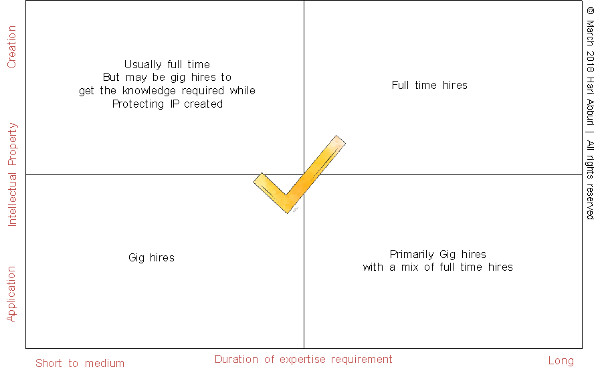[By Gerd Altmann, under Creative Commons]
We hear a lot of buzz on the gig economy and gig workers. I prefer to call these two the gig talent economy. While it is easier for certain types of industries—for example consulting—to bring in skilled contract workers as a key component of their talent strategy, it is a talent pool that all industries will find relevant, though they may not have studied this as a strategy yet.
Take EY as an example. Its GigNow platform aims to create a dedicated and distinct identity for attracting gig talent.
The Definition and Numbers
The gig economy refers to the “urbanisation” of the workforce, or the increase in the percentage of the workforce participating in contingent work. Contingent workers include: Any employee paid by task or by project and considered to be in a temporary relationship with your organisation, which could range from on-demand workers who perform a single-day job to long-term contractors even up to the senior executives brought in to manage a company’s transformation.
McKinsey Global Institute’s James Manyika and Susan Lund, in their paper ‘Independent Work: Choice, Necessity, and the Gig Economy’ say: “Some public estimates place the amount of the workforce involved in contingent work as high as 40%. Another recent study cites 20%–30% of the working-age population in the United States and the EU (as many as 162 million individuals) as engaging in contingent work.”
Understanding the Trend
a. Jobs created per dollar earned is slower and lower
Since the last economic crisis driven by the sub-prime bubble, we have seen more of a jobless economic recovery. For the same state of business health before the crisis and after the crisis, companies are growing with lesser number of employees.
In a recently published article in Inc., Leigh Buchanan writes about ‘Why Companies Are Operating Lean (Even When They Can Afford to Hire)’. She points out: “The data shows that fast-growing companies are hiring fewer people, even as revenue swells—and even while it’s the credo of politicians, the press, and entrepreneurs that starting companies means creating jobs.”
b. The gap between education and employment
In his Wall Street Journal write-up ‘Why an Honors Student Wants to Skip College and Go to Trade School’, Douglas Belkin points to an increasing trend of school students in the US opting for vocational courses rather than four-year degrees.
“These forces are leading to a course correction now rippling through US high schools, which are beginning to re-emphasise vocational education, rebranded as career and technical education. Last year, 49 states enacted 241 policies to support it, according to the Association for Career and Technical Education, an advocacy group.”
He continues, “The conversation is being fuelled by questions about the declining value of a college degree as well as the rising cost of tuition and student debt. Low unemployment and a strong job market are exacerbating an already growing skills gap, raising prospects for tradespeople like welders who are in high demand.”
The US is not alone in this. In a country with a large population like India, gig talent is a good answer to unemployment. In a column in Livemint, Ruchira Chaudhary examines whether India is ready for the gig economy. Such a focus on vocational education will only add to the gig workforce available to both small businesses and large companies.
c. Automation and displacement of the workforce
This is a widely discussed topic. A McKinsey Global Institute study, ‘A future that works: Automation, employment and productivity’, states that jobs with repeatable physicals, processing or that involve collecting data will be automated. The authors estimate that about 60% of occupations have at least 30% of activities that can be automated. This will lead to more of the employed shifting to being gig workers. This also leads to future solutions for social security such as universal basic income.
The Link between Gig Talent and Agile HR
So, where are the people falling out of the organised employment sector and what are they doing? How can you find this talent pool and organise them to your benefit?
In my earlier columns on how agile companies need an agile HR first and how companies can integrate gig talent into strategic workforce planning, I’ve explored the idea that gig talent is the new talent pool. That companies that cannot adapt their thinking on talent to include such workers will lose out on deep-expertise in their talent strategies.
When it comes to the HR function itself, it requires multiple big shifts, one of which is that 20%-40% of the headcount within HR needs to be gig talent. This will allow HR to deploy deep expertise in real time and be present at the point of need anywhere globally (and in accordance with labour regulations).
Here are some of the ways that gig talent drives agility in HR:
- Hiring gig talent is about getting deep expertise, and not about driving down cost. In fact, in most cases we found gig workers were paid similar to or higher than employees for their specialisation.
- Gig talent is everywhere. In each country, language and culture, you will find people with expertise who can contribute with very little lag time.
- It is about speed of expertise—delivering capability ahead of time.
- It is the best answer to expensive travel-based deployment of people at the global, regional, or country level.
- Gig talent as a percentage of HR headcount can change, adapt and scale rapidly based on the context. For example, when you need expertise to manage a turnaround, or mergers and acquisitions, or strategic projects.
The best part is that gig talent in HR does not need to be HR talent. For example, if your HR function wants to build an augmented reality (AR)-based training module, it can be done with far greater capability by hiring an AR design and delivery expert rather than the learning function partnering with IT to get this done.
Simplicity is another big factor in HR agility. The HR function has become increasingly over-specialised and over-engineered. One of the reasons is that it continues to have a headcount with at least 20% slack time. Gig talent will be key to driving simplicity in HR as they are not full time in a company. Full time HR headcount creates complexity in their slack time.
But the key is to understand the ‘deep-expertise’ aspect of gig talent and integrating that into your talent strategy and strategic workforce planning.
In a LinkedIn blog post, Janina Kugel, chief human resource officer (CHRO) at Siemens, talks about being agile and deploying experts quickly at the point of need. However, she does not mention or may not have considered having gig talent in HR as a core part of transformation. This could be a game changer in deploying experts. Especially for a company that operates in multiple cultures, contexts and with multiple business imperatives.
Finding Gig Talent for HR
I am a huge fan of Starbucks. For its hot soy chai tea latte and for training me to be a customer. But more so as an appreciation of how much of a hub it is for gig talent. There may be an area for it to consider expanding to—to become a platform to find gig talent combined with being a co-working space. Here are a few other existing platforms: Up Work, Fiver, Task Rabbit, Hire my mom.
On the HR front, we see the emergence of specialised firms. The Belgium and Europe based HRbuilders and Noble House Asia from Singapore are two such examples. EIM too has an HR practice on interim executive staffing. While LinkedIn is a key platform, it will be disrupted on the gig talent front if it does not adapt or evolve.
Sofia Van Overmeire from HRbuilders explained that the requests they received in 2017 for gig talent across Western Europe in HR were for HR generalists (36%), and in the areas of talent acquisition (25%), compensation and benefits (10%), and human resource information system, or HRIS (7%). The learning and development area, which was traditionally open to hiring freelancers or temporary staffing, stood at just 4%.
She highlights that the UK and the Netherlands are very mature in this market. Germany and Belgium are catching up with the previous early adopters. In the Nordic countries the labour system is already flexible, hence the need for gig talent is less than in other regions and the concept as we discuss in this article is less known. The lack of social security and benefits plus the feeling of not having jobs security are major reasons for the slower development of this talent pool in France, Spain, Portugal and Italy. This is also explained by Helen Fouquet in her article ‘France’s gig workers are desperate for Macron to fix the rules”.
Noble House Asia, an HR gig talent startup, has seen a good response. Co-founder Sanjay Lakhotia says the biggest demand for HR gig talent in Southeast Asia is in the areas of training and development, leadership development and talent acquisition.
Lakhotia highlights four big challenges he sees in the adoption of gig talent in HR: Awareness and availability of such talent, quality of freelancers, culture fit and scoping of assignments accurately. He says, “Indian HR professionals are still not ready to think how HR freelancers can fit and understand the organisation culture.”
How do the gig talent perform as compared to full time employees? In my view far better. Katherine Kuhn of Elite HR Advisor, which is the US partner of HRbuilders, says it the best: “The freelance or gig worker in a company is held to far higher standard on performance than a regular full time employee. Also for gig talent, their work is their performance else they will not survive.” She believes that the learning curve of a gig worker is far better than a full time employee who has been with a company for a long time.
Wolfgang Doerfler, partner at EIM with whom I co-authored an earlier paper on gig talent and workforce planning, says there is significant demand for HR professionals in the lower and middle levels. He also finds that companies are experiencing so much change that they lose staff and engaged employees. They then scramble for interim staffing in key roles. However, details like location, regulations, etc play a role. He believes that ‘oversized’ (those with more than necessary experience) temporary managers create huge value like in the case of a project in the Romanian subsidiary of a global company with 350-plus employees.
An interim senior HR executive was sent in to manage a turnaround in the face of huge staff turnover and lack of engagement. He created significant value to the company in this situation.
Is there a Model We Can Apply to Adopt Gig Talent In HR?
In an earlier article, I had laid out an approach to adopting gig talent through comprehensive strategic workforce planning. You can adopt gig talent into the HR function with these two broad steps. This can be further layered with location of the role/job or this could be done virtually as well.
1. Understand the intellectual property impact of hiring gig talent

2. Know why you need the gig talent to replace a job typically done by a full time employee so far. (Reproduced from Gig it up)
| Plug and play | Turn-around specialists | Domain specialists | General/functional management |
|
The most common today where there is need for someone to hold the fort or fill the gap or vacancy temporarily, this is mostly reactive. |
These are typically in response to a crisis—for example a break-down in processes or operations, or when the whole company is at stake or specialist resources in cases of plant shut down or market or product closures. |
This is where specific specialisation is needed to solve a problem or deliver a project or contribute to a high growth business. This has contours of a specific deliverable, etc. This is not necessarily determined by time. Book editing, graphic designer, quality assessor, employee benefit programmes designer, etc. |
These are experienced professionals who have the depth and gravitas to step into interim roles heading functions or business verticals either at CEO -1 or CEO -2 levels that bring in both strategy and implementation expertise in case of M&As, transformations, hive-offs, etc. |
Is Gig Talent an Answer to Organisational Slack?
I recently had lunch with the very insightful Robert Kazanjian, Asa Griggs Candler Professor of Organization and Management at Goizueta Business School of the Emory University.
In my enthusiastic way, I shared with him an example of a company that found an innovative way for its employees to ‘gig’ on projects.
He looked up and said, “Don’t you think that is the level of organisational slack [excess capacity] in that company?”
He had a point. If gig talent fills the ‘slack’ in an organisation, it adds to agility. Many companies have created seasonal workforce models to manage flexibility for their businesses.
However, I do believe that with all the market forces and trends, gig talent is a serious pool of talent to understand, plan for and integrate into a company’s talent strategy. In the gig economy, especially in the Ubers of the world, as Peter Campelli writes, Are Algorithms Good Managers in the Gig Economy?
Companies will need to adopt technology platforms to manage gig talent pools. A key element of this talent pool is the ability to deploy virtually across country boundaries. This, combined with the need for a systematic approach to hiring, measuring performance and rewarding gig talent, will necessitate implementation of such technology platforms within companies.
So, designing a new integrated approach to talent is an essential starting point.
Five Changes to Make Gig Talent a Reality
Gig talent does add agility to HR, by bringing in deep expertise. Adoption of gig talent can be accelerated if HR can work upon these five areas:
- Their own mindset, and rapidly. Often HR comes in its own way to accelerate innovation or new practices or new culture.
- Integrate all types of talent, to help managers adapt to the new pool of talent positively.
- Re-imagine the four areas of HR key to gig talent: Workforce planning, hiring, performance management and rewards.
- Build a framework to retain knowledge in the company even though the work is done by gig workers.
- Look at gig workers as a potential pool of successors to key internal roles staffed by full time employees.
Gig talent is a promising area of talent. It can be truly global as it tears down talent availability and deployment without borders.
However, it has its share of challenges around IP protection, confidentiality, conflict of interest and labour regulations. It is only a matter of time before companies find smart approaches to these challenges rather than say no to an extraordinary gig talent pool.
Without doubt, HR must lead the way and be ahead of time in every industry, culture, market and company.

